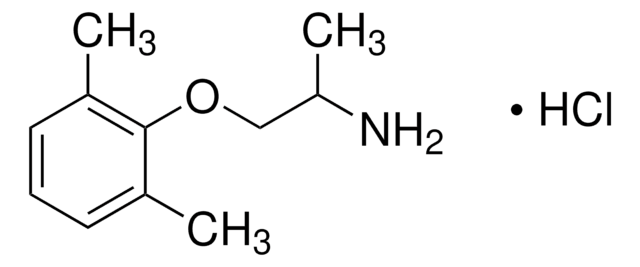おすすめの製品
品質水準
アッセイ
≥98% (HPLC)
フォーム
powder
保管条件
desiccated
色
white to beige
溶解性
DMSO: 2 mg/mL, clear
保管温度
−20°C
SMILES記法
Cl.N3(C[C@@H](CC3)O)[C@H]1[C@@H](CCCC1)OCCc2cc(c(cc2)OC)OC
InChI
1S/C20H31NO4.ClH/c1-23-19-8-7-15(13-20(19)24-2)10-12-25-18-6-4-3-5-17(18)21-11-9-16(22)14-21;/h7-8,13,16-18,22H,3-6,9-12,14H2,1-2H3;1H/t16-,17-,18-;/m1./s1
InChI Key
JMHYCBFEEFHTMK-IIUXMCBISA-N
関連するカテゴリー
生物化学的/生理学的作用
Anti-arrhythmic that exerts anti-fibrillatory efficacy via potential- & rate-dependent Nav1.5 (SCN5A) as well as atrial-selective Kv1.5 (KCNA5) blockade in vivo.
Vernakalant is a multiple ion channel blocker that exerts in vivo anti-fibrillatory (anti-arrhythmic) efficacy (ED50 = 1.5 μmol/kg/min iv. against ischemia-induced arrhythmias in rats) via atrial-selective Kv1.5 blockage (hKv1.5/rKv4.2/rKv4.3 IC50 = 13/38/30 μM at 1Hz & -80 to 60 mV in 200 (Kv1.5) or 400 (Kv4) msec) as well as potential- and rate-dependent Nav1.5 blockade (inward Na current INa IC50 = 9 μM/20 Hz & -80 mV, 31 μM/1Hz & -60 mV, 107 μM/1Hz & -120 mV using HEK hNav1.5 cells).
保管分類コード
11 - Combustible Solids
WGK
WGK 3
引火点(°F)
Not applicable
引火点(℃)
Not applicable
最新バージョンのいずれかを選択してください:
試験成績書(COA)
Lot/Batch Number
Gerrit Frommeyer et al.
Journal of cardiovascular medicine (Hagerstown, Md.), 18(9), 663-668 (2017-07-12)
Current guidelines recommend vernakalant for pharmacologic cardioversion of recent-onset atrial fibrillation. However, this drug is not established as chronic therapy. In total, 15 rabbit hearts were Langendorff-perfused. A burst pacing protocol-induced atrial fibrillation in 7 of 15 hearts at baseline
Toshiki Chiba et al.
Journal of pharmacological sciences, 130(3), 170-176 (2016-04-02)
Electrical remodeling plays a pivotal role in maintaining the reentry during atrial fibrillation. In this study, we assessed influence of electrical remodeling on pharmacological manipulation of the atrial refractoriness in rabbits. We used an atrial electrical remodeling model of the
Jonas Goldin Diness et al.
Circulation. Arrhythmia and electrophysiology, 10(10) (2017-10-12)
Evidence has emerged that small-conductance Ca2+-activated K+ (SK) channels constitute a new target for treatment of atrial fibrillation (AF). SK channels are predominantly expressed in the atria as compared with the ventricles. Various marketed antiarrhythmic drugs are limited by ventricular
Gerrit Frommeyer et al.
Europace : European pacing, arrhythmias, and cardiac electrophysiology : journal of the working groups on cardiac pacing, arrhythmias, and cardiac cellular electrophysiology of the European Society of Cardiology, 19(5), 866-873 (2016-10-06)
The antiarrhythmic drug vernakalant exerts antiarrhythmic effects in atrial fibrillation. Recent experimental data suggest interactions with the late sodium current and antiarrhythmic effects in ventricular arrhythmias. We aimed at investigating whether treatment with vernakalant reduces polymorphic ventricular tachycardia (VT) in
Rong Chen et al.
Biochemistry, 57(18), 2704-2710 (2018-04-14)
Molecular dynamics simulations are employed to determine the inhibitory mechanisms of three drugs, 5-(4-phenoxybutoxy)psoralen (PAP-1), vernakalant, and flecainide, on the voltage-gated K+ channel Kv1.5, a target for the treatment of cardiac arrhythmia. At neutral pH, PAP-1 is neutral, whereas the
ライフサイエンス、有機合成、材料科学、クロマトグラフィー、分析など、あらゆる分野の研究に経験のあるメンバーがおります。.
製品に関するお問い合わせはこちら(テクニカルサービス)







